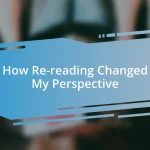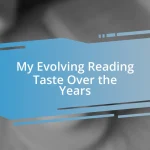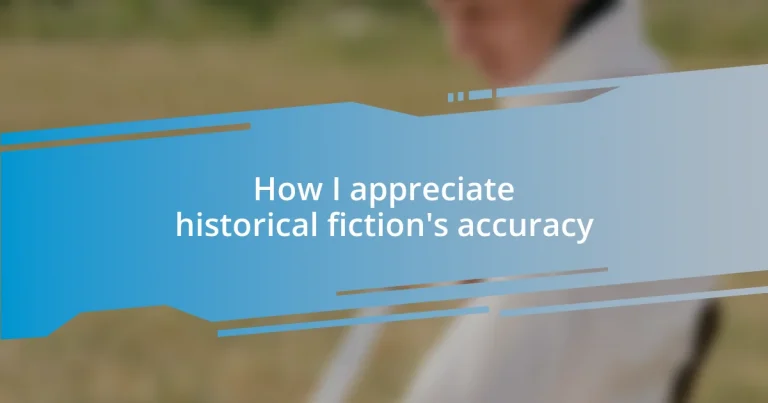Key takeaways:
- Historical fiction bridges the past and present, making history engaging and relatable while prompting critical reflection on human experiences.
- Accuracy in historical fiction encompasses factual correctness, emotional truths, character representation, and contextual accuracy, highlighting the subjective nature of historical narratives.
- Reading historical fiction enriches understanding of societal issues, challenges personal beliefs, and encourages introspection about contemporary struggles and responsibilities.
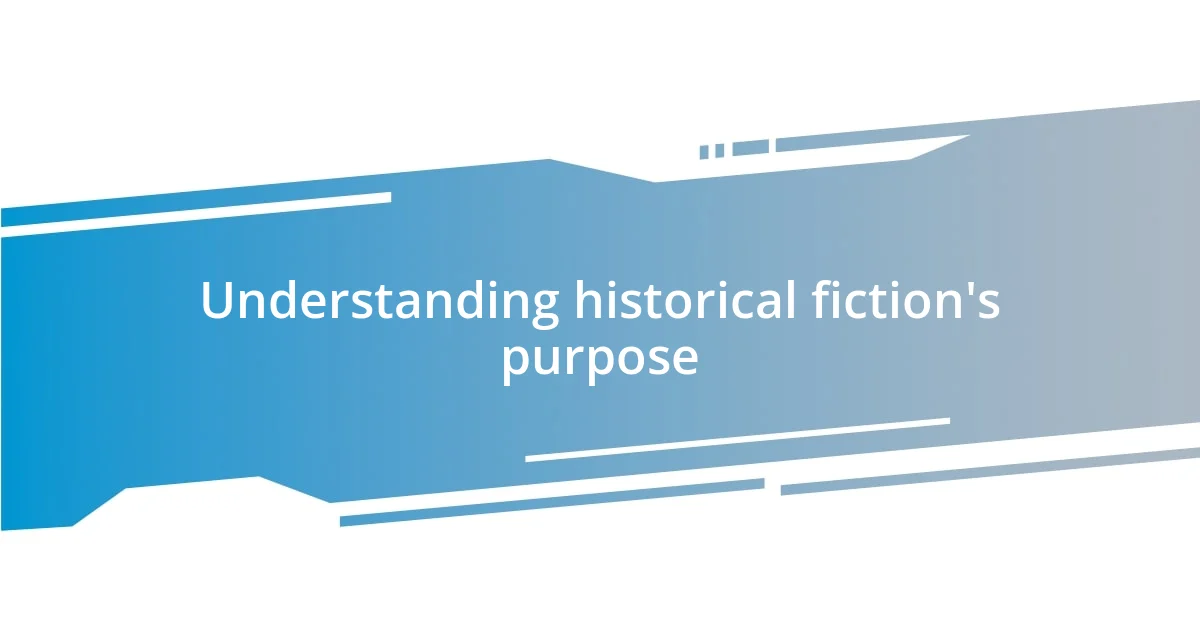
Understanding historical fiction’s purpose
Historical fiction serves a compelling purpose: it bridges the gap between the past and present, making history accessible and engaging. I remember picking up a novel set during the tumultuous days of the American Revolution and being instantly drawn in, not just by the thrilling narrative, but by the rich details that brought those events to life. Have you ever felt that rush of connection when you read about a historical figure and realize they were shaped by the same struggles and dreams we face?
By weaving real events with imaginative storytelling, historical fiction allows us to explore the emotional landscape of historical figures. I often find myself reflecting on the fears and hopes of characters facing monumental change, leading me to question how I navigate my own struggles. Isn’t it fascinating how these stories can resonate so strongly within us, offering both lessons from the past and insights for the future?
Furthermore, the genre encourages us to critically engage with history, prompting us to ask, “What are the nuanced truths behind these events?” Through the lens of historical fiction, we can challenge our perceptions and uncover stories that might have been overlooked or silenced. This exploration not only enriches our understanding but also deepens our empathy for those who lived through these pivotal moments in time.
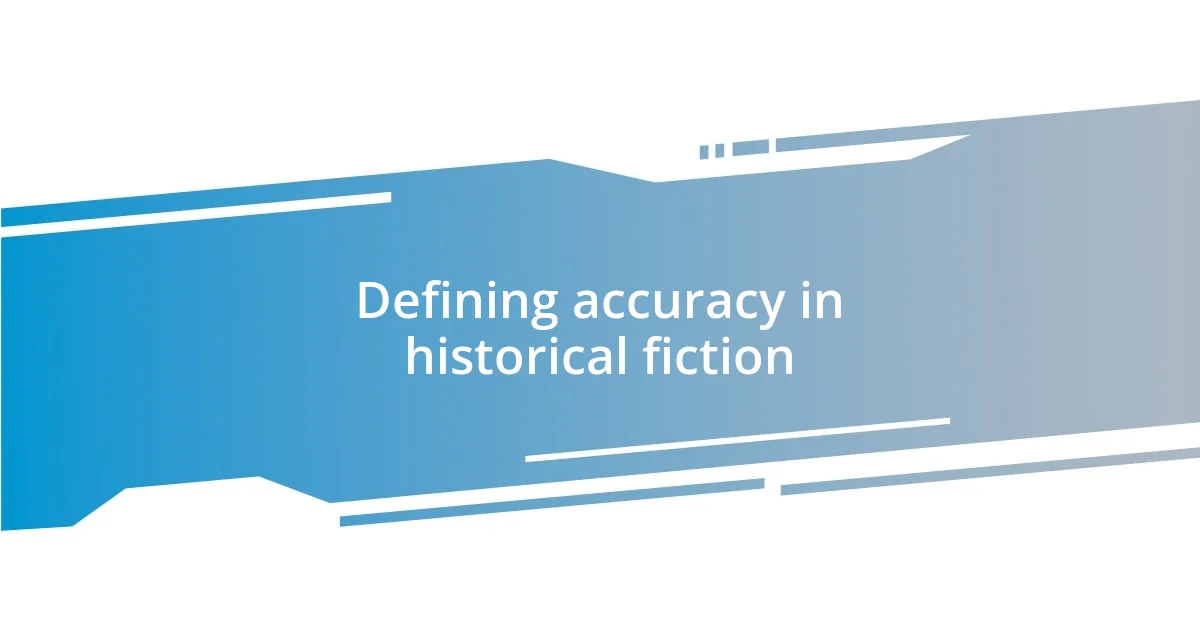
Defining accuracy in historical fiction
Defining accuracy in historical fiction is multi-faceted. When I consider accuracy, I think about the delicate balance between factual correctness and narrative invention. For instance, I once read a novel where the protagonist mingled with real historical figures. While I enjoyed the creative liberties taken, I couldn’t help but wonder how much of the actual dialogue was imagined versus documented. This reflection reminds me that accuracy isn’t just about dates and events; it’s also about understanding the human experience behind those facts.
Moreover, the term ‘accuracy’ can vary significantly among writers and readers alike. I’ve encountered fans who prioritize factual fidelity above all else, scrutinizing every detail, while others value the emotional truths conveyed through character experiences. I often ask myself: does a well-developed character who embodies the spirit of the times hold more weight than an exact timeline? This has led me to appreciate how subjective the notion of accuracy can be in this genre.
Finally, it’s essential to consider the underlying themes and societal contexts presented in these works. For example, a historical novel might shine a light on the struggles of a particular group, even if its main storyline incorporates embellishments. I recall vividly how a story focusing on the suffragette movement not only taught me about events I hadn’t learned in school but also sparked a conversation about women’s rights that felt relevant even today. In this light, accuracy evolves beyond just historical dates; it becomes a vehicle for deeper understanding and connection.
| Aspect | Description |
|---|---|
| Factual Accuracy | Refers to the precise representation of historical events, dates, and figures. |
| Emotional Truth | Captures the essence of human experiences and sentiments during the historical period. |
| Character Representation | Focuses on how characters reflect or embody the traits of their time. |
| Contextual Accuracy | Involves presenting the societal and cultural context accurately, even if the plot is fictionalized. |
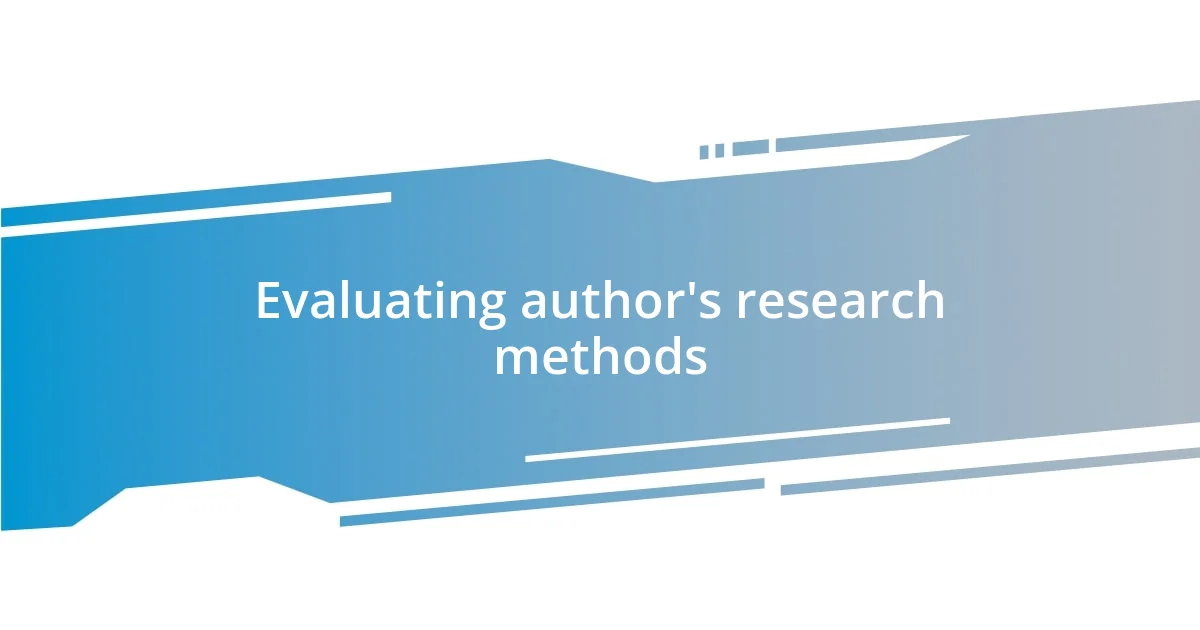
Evaluating author’s research methods
When I delve into a historical fiction book, one of the first things I evaluate is the author’s research methods. The way they blend fact with fiction can give me insights into their commitment to authenticity. I once read a novel set in Ancient Rome where the author meticulously incorporated not only the political climate but also the everyday life of its citizens. It was clear they spent considerable time researching the language, customs, and even the diet of the time, which truly enriched my reading experience.
To assess an author’s research methods, consider the following aspects:
- Sources Utilized: Are there notes or a bibliography that reveal a variety of academic sources?
- Depth of Research: Does the author weave in obscure facts or intimate details that indicate deeper understanding?
- Consistency: Are the historical details internally consistent throughout the narrative?
- Engagement with Experts: Has the author consulted historians or experts in the field?
- Personal Connections: Do they share experiences or anecdotes that reflect their immersion in the subject matter?
In a particularly memorable instance, I encountered an author who described visiting archives and museums to better grasp the subtleties of their characters’ lives. This level of dedication piqued my interest and made me appreciate their effort to present a vivid and believable world. Each of these elements not only enhances the narrative but helps me connect more deeply with the story unfolding on the page.
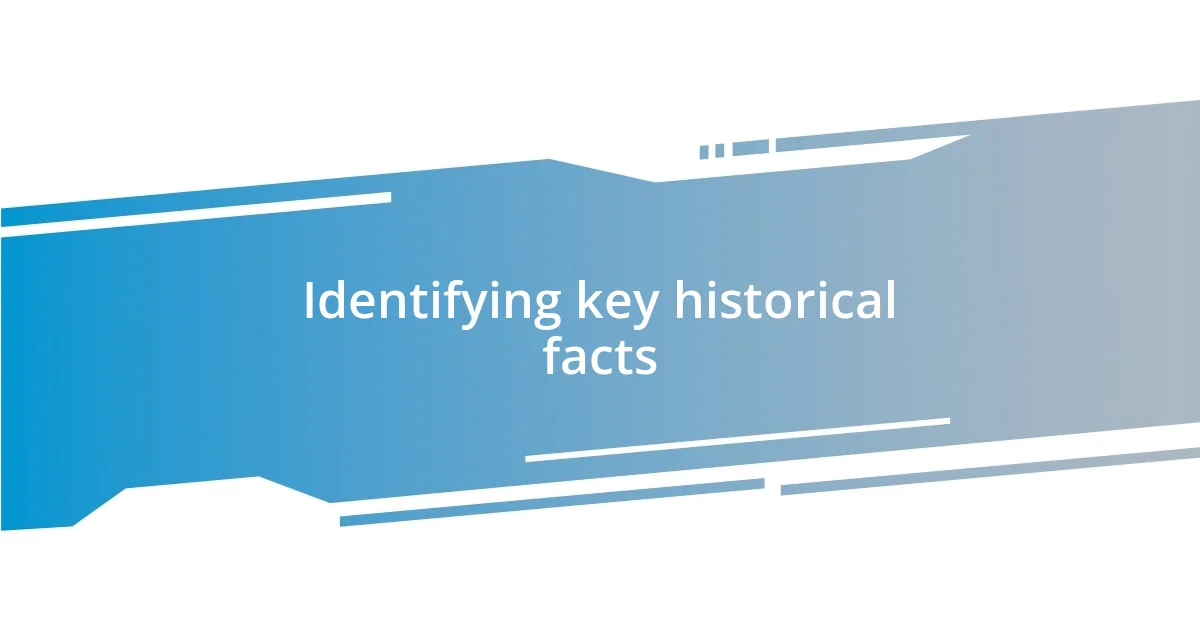
Identifying key historical facts
Identifying key historical facts in a novel often requires careful attention to detail. I remember picking up a book set during the American Civil War, where I constantly found myself checking dates and events against what was taught in school. It was fascinating for me to see how the author captured critical battles and political shifts, but also how they chose to highlight lesser-known figures who played pivotal roles. Have you ever wondered how a single obscure fact can change your perspective on historical narratives? It certainly did for me.
Another aspect that struck me was the interplay of personal stories within larger historical events. While reading, I encountered a character whose family had deep roots in the cotton industry during the antebellum period. The emotional nuance behind their struggle to reconcile wealth with the ethical dilemmas of slavery added layers of meaning. It made me realize that historical facts aren’t just about what happened—they’re also embedded in the lives of real people, which is something I believe historical fiction should strive to convey.
As I reflect on my reading experiences, I find that identifying key historical facts goes beyond just recognizing significant dates. It’s about drawing connections between events and understanding the ripple effects they’ve had through time. For instance, after finishing a novel about World War II, I spent hours researching how individual actions in wartime could lead to both monumental change and personal heartbreak. This pursuit of knowledge breathes life into stories, making them resonate even more profoundly for me as I strive for a deeper comprehension of history.
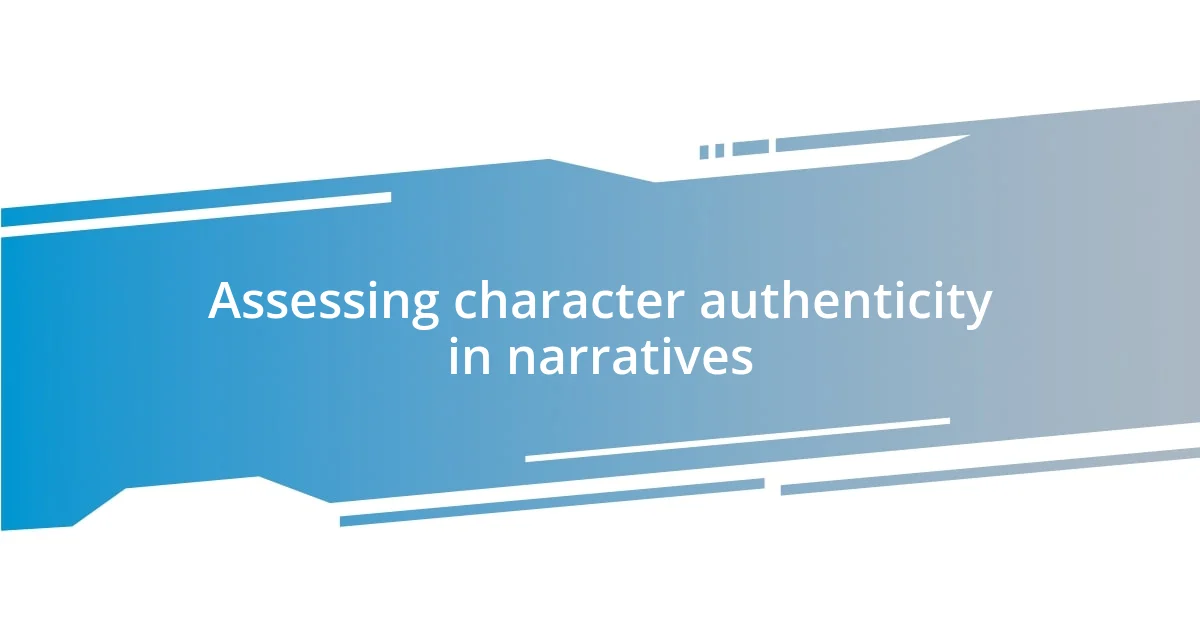
Assessing character authenticity in narratives
When I immerse myself in a historical narrative, assessing character authenticity becomes one of my favorite aspects. I find that believable characters often reflect the values, struggles, and complexities of their time periods. For instance, I read a novel set in the 1800s, featuring a young woman challenging societal norms. Her bravery resonated deeply with me, as I felt the emotional weight of her decisions, which mirrored real-life struggles from the era. Isn’t it fascinating how well-drawn characters can turn history into something palpably relatable?
Equally important is how characters interact with their historical context. I vividly recall a story about a soldier during the Revolutionary War, who not only fought battles but also grappled with loyalty to his family and the emerging ideals of a nation. This multidimensional portrayal made me ponder how individuals are often torn between personal desires and larger historical movements. How often do we see ourselves reflected in the experiences of those who lived long before us? It’s a powerful reminder that the human experience transcends time.
As I navigate through these narratives, I also look for character development that feels genuine. Characters who evolve in response to their historical circumstances bring a sense of realism that’s hard to ignore. I remember a tale of a master who began questioning the morality of slavery as he watched his family’s slaves form intricate bonds of community. His transformation felt like a slow burn, highlighting the internal conflicts many faced during that tumultuous era. Such nuanced portrayals not only engage me but also prompt me to reflect on the complexities of morality in my own life. Isn’t it enlightening to realize how these historical characters can serve as mirrors to our own challenges and growth?
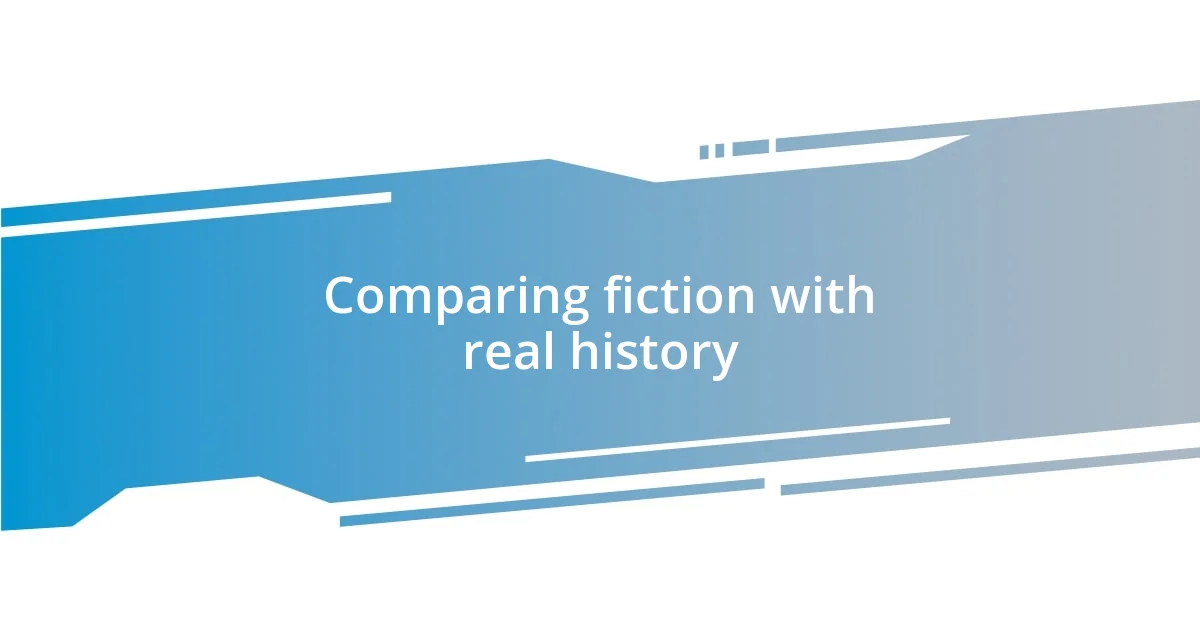
Comparing fiction with real history
When I delve into historical fiction, comparing what’s presented in the narrative with actual events can be quite eye-opening. I recall reading a novel set in ancient Rome, where the fictionalized accounts of political intrigue were woven seamlessly with real historical figures. This blend made me question how much of our understanding of history is shaped by the stories we tell. It’s interesting to think about whether the embellishments enhance the truth or obscure it—has anyone else felt this tension while reading?
One particular instance comes to mind when I encountered a fictional tale about a famous revolution. The author portrayed events with such vivid detail that I couldn’t help but research the actual timelines and figures involved. It made me realize that while fiction allows for creative freedom, it also invites a responsibility to honor the essence of those true events. How does one strike that balance? This thought lingered with me as I pondered over the way narratives can honor or distort historical truth.
Furthermore, the emotional weight behind historical accuracy can’t be understated. I once read a story centered around a family during the Great Depression, with characters experiencing real struggles that echoed the actual hardships of the time. It felt surreal to navigate those fictional lives while being acutely aware of the statistics and reality behind those experiences. Isn’t it amazing how a novel can bring a historical moment to life, allowing us to connect with emotions that transcend time? I find that this kind of emotional engagement can deepen our understanding of the human condition, making history feel relevant today.
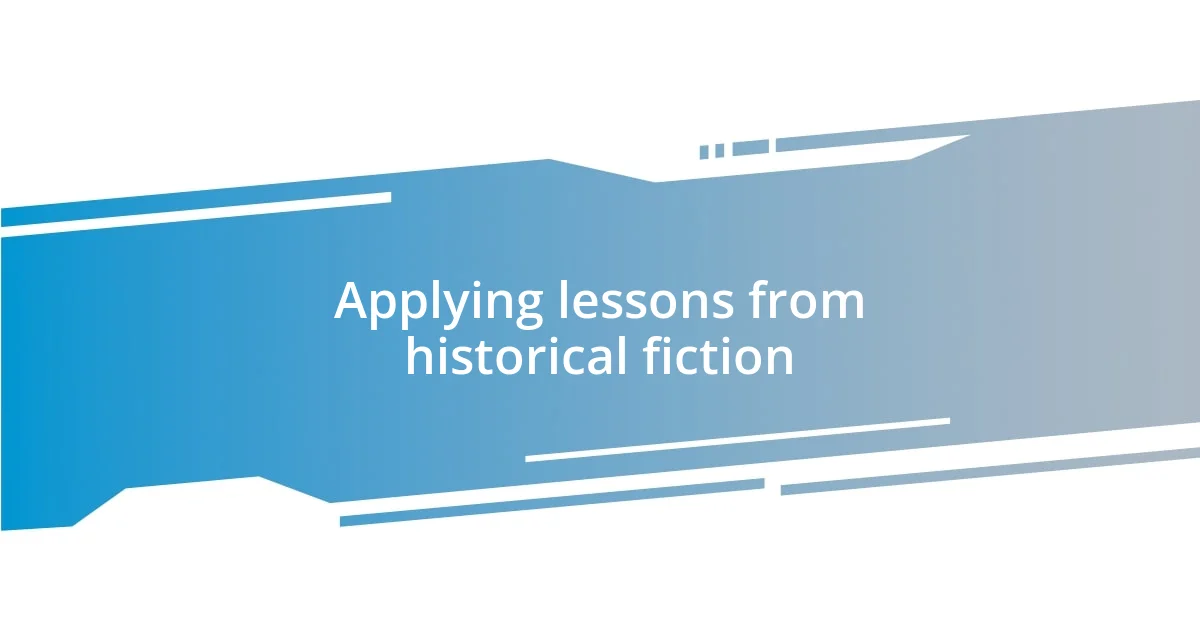
Applying lessons from historical fiction
Once I finished a gripping historical novel set during World War II, I found myself reflecting on the motivations behind the characters’ choices. The author painted a vivid picture of individuals torn between duty and personal beliefs. This made me realize how often we face similar dilemmas in our own lives. Doesn’t it make you think about the weight of our decisions and how they resonate beyond our immediate circumstances?
There was a time when I read a story about a suffragette, fiercely advocating for women’s rights. Her relentless spirit inspired me to evaluate my own views on social justice today. It was eye-opening to see how past struggles can illuminate present-day challenges. How often do we draw strength from the stories of those who fought for change? It’s incredible how these narratives urge us to confront our own roles in the ongoing fight for equality.
I recall engaging in a book club discussion about a historical narrative that revolved around colonization. As we discussed the characters’ internal conflicts, I felt a growing awareness of the repercussions of their choices. The story challenged me to consider the lasting impact of history on current societal structures. Isn’t it something to reflect upon how these lessons from the past can shape our actions today? Diving into these tales not only enriches my understanding but also prompts a deeper introspection about our place in history.




